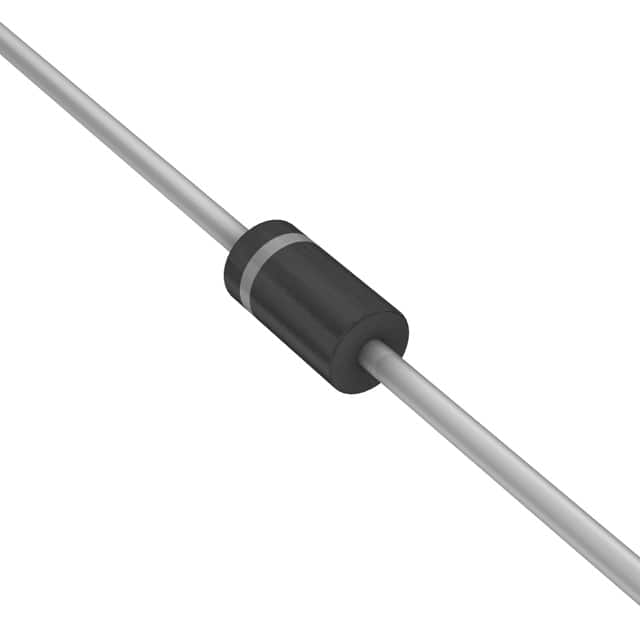Xem thông số kỹ thuật để biết chi tiết sản phẩm.

MUR160 Diode: Encyclopedia Entry
Introduction
The MUR160 diode is a crucial component in electronic circuits, belonging to the category of rectifier diodes. This entry provides an overview of the MUR160 diode, including its basic information, specifications, pin configuration, functional features, advantages and disadvantages, working principles, application field plans, and alternative models.
Basic Information Overview
- Category: Rectifier Diode
- Use: The MUR160 diode is primarily used for converting alternating current (AC) to direct current (DC) in power supply applications.
- Characteristics: It exhibits low forward voltage drop, high surge capability, and fast switching speed.
- Package: The MUR160 diode is commonly available in a DO-201AD package.
- Essence: It serves as a reliable component for rectification and power conversion.
- Packaging/Quantity: Typically packaged in reels or tubes containing multiple units.
Specifications
The MUR160 diode has the following key specifications: - Maximum Average Forward Current: 1A - Peak Reverse Voltage: 600V - Forward Voltage Drop: 0.95V at 1A - Reverse Recovery Time: 35ns - Operating Temperature Range: -65°C to +175°C
Detailed Pin Configuration
The MUR160 diode has a standard DO-201AD package with two leads. The pin configuration is as follows: - Pin 1: Anode - Pin 2: Cathode
Functional Features
- Fast Switching: The MUR160 diode offers rapid switching characteristics, making it suitable for high-frequency applications.
- High Surge Capability: It can withstand high surge currents, ensuring robust performance in transient conditions.
- Low Forward Voltage Drop: This feature minimizes power loss and enhances energy efficiency in rectification processes.
Advantages and Disadvantages
Advantages
- Efficient power conversion
- Fast response time
- High surge capability
Disadvantages
- Limited reverse voltage tolerance compared to some higher-rated diodes
- Sensitive to temperature variations
Working Principles
The MUR160 diode operates based on the principle of unidirectional conduction, allowing current flow in one direction while blocking it in the reverse direction. When forward-biased, it conducts current with minimal voltage drop, facilitating efficient rectification.
Detailed Application Field Plans
The MUR160 diode finds extensive use in various applications, including: - Power supply units - Inverters and converters - Battery charging circuits - Switch-mode power supplies - Motor drives
Detailed and Complete Alternative Models
Several alternative models to the MUR160 diode include: - 1N4007: A general-purpose rectifier diode with a higher reverse voltage rating - UF4007: Ultrafast rectifier diode with improved recovery time - FR107: Fast recovery rectifier diode suitable for high-frequency applications
In conclusion, the MUR160 diode serves as a vital component in power electronics, offering efficient rectification and reliable performance in diverse applications.
Word Count: 411
Liệt kê 10 câu hỏi và câu trả lời thường gặp liên quan đến ứng dụng MUR160 trong giải pháp kỹ thuật
What is the MUR160 diode used for?
- The MUR160 diode is commonly used for rectification and freewheeling applications in power supplies, inverters, and other electronic circuits.
What are the key features of the MUR160 diode?
- The MUR160 diode features a high surge capability, low forward voltage drop, fast switching speed, and low reverse recovery time.
What is the maximum forward current rating of the MUR160 diode?
- The maximum forward current rating of the MUR160 diode is typically 1A.
What is the reverse voltage rating of the MUR160 diode?
- The reverse voltage rating of the MUR160 diode is 600V.
Can the MUR160 diode be used in high-frequency applications?
- Yes, the MUR160 diode can be used in high-frequency applications due to its fast switching speed and low reverse recovery time.
How does the MUR160 diode perform in temperature extremes?
- The MUR160 diode has a wide operating temperature range and performs well in temperature extremes.
Is the MUR160 diode suitable for use in bridge rectifier configurations?
- Yes, the MUR160 diode is commonly used in bridge rectifier configurations for converting AC to DC.
What are some typical applications of the MUR160 diode?
- Typical applications of the MUR160 diode include power supplies, battery chargers, motor drives, and lighting systems.
Does the MUR160 diode require a heatsink for certain applications?
- Depending on the application and operating conditions, the MUR160 diode may require a heatsink to dissipate heat effectively.
Are there any common failure modes associated with the MUR160 diode?
- Common failure modes of the MUR160 diode include overcurrent conditions, excessive reverse voltage, and thermal overstress. Proper design and application considerations can mitigate these risks.

